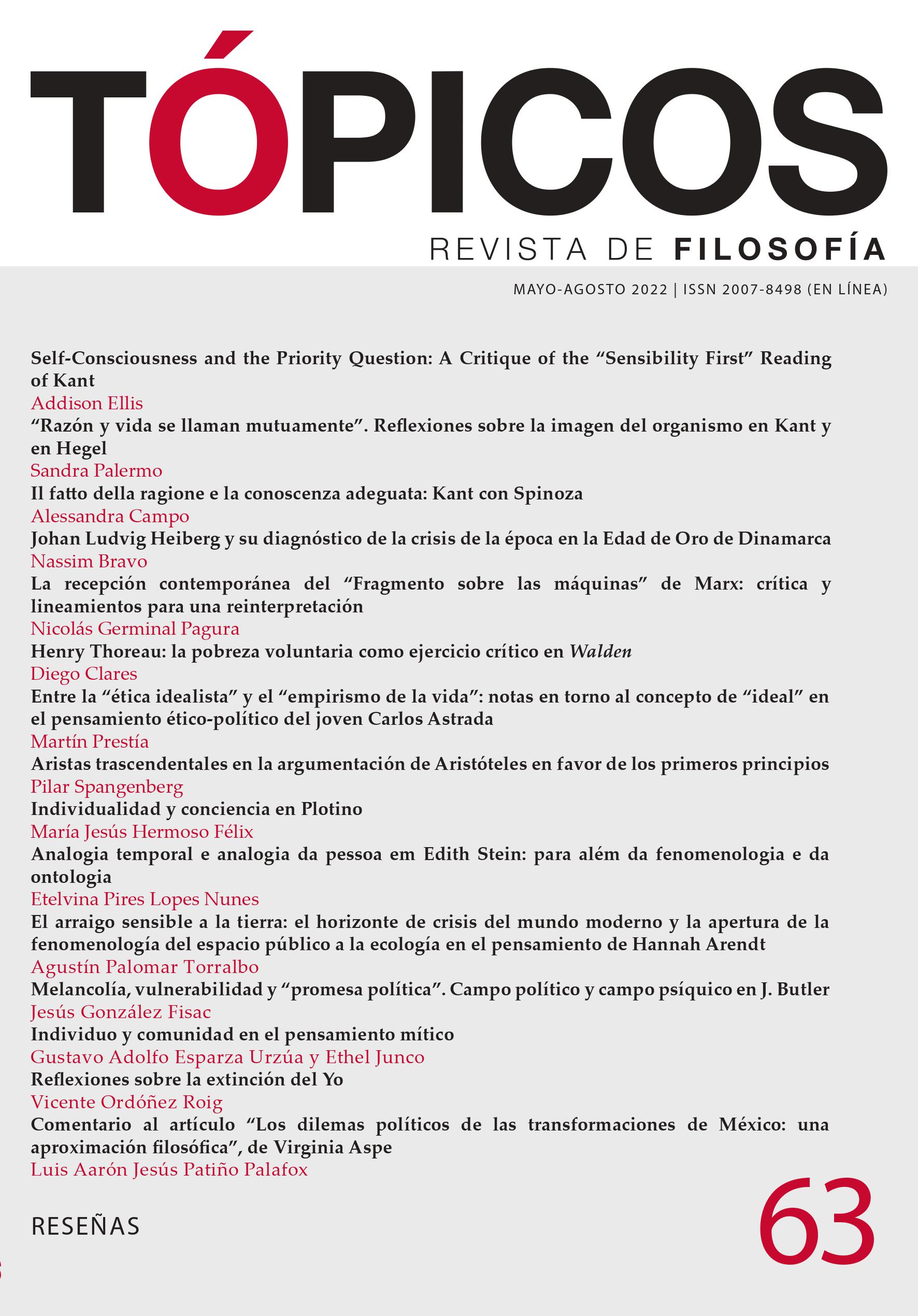Analogia temporal e analogia da pessoa em Edith Stein: para além da fenomenologia e da ontologia
Publicado 2022-04-18
Palabras clave
- ser infinito,
- ser eterno,
- analogia temporal,
- analogia pessoal,
- fenomenologia
- ontologia ...Más
Derechos de autor 2022 Tópicos, Revista de Filosofía

Esta obra está bajo una licencia internacional Creative Commons Atribución-NoComercial-SinDerivadas 4.0.
Cómo citar
Resumen
Este artigo apresenta o processo que Stein elabora para estabelecer a relação do ser finito e temporal com o ser infinito e eterno. Contextualizando a sua investigação no âmbito da fenomenologia e da ontologia, Stein ultrapassa estes domínios. Na esteira de Tomás de Aquino, será recorrendo à analogia que Stein traça a ascensão para o sentido do Ser. No entanto, este processo tornar-se-á mais próximo da posição de S. Agostinho. Pois, a autora elabora primeiro uma analogia temporal e depois uma analogia pessoal. Parte de duas evidências: a certeza do “eu sou” de Agostinho, Descartes e Husserl e o “eu sou” divino, segundo o nome que Deus revelou de si próprio: “Eu sou aquele que sou” (Ex 3,14). Através da analogia pessoal a autora ultrapassa a fenomenologia e a ontologia, enquanto a categoria “pessoa” compreende tanto o ser como uma plenitude atribuída.
Referencias
- Agostinho. (1948). Obras de San Agustín. Volumen V. Tratado sobre la Santísima Trinidad. L. Arias (trad.). Biblioteca de Autores Cristianos.
- Bouillot, B. (2015). Le noyau de l’âme selon Edith Stein : De l’épochè phénoménologique à la nuit obscure. Hermon éditeurs.
- Betschart, C. (2017). L’interprétation structurelle et relationnelle de l’imago Dei. Proposition d’articulation à partir d’Edith Stein et sa conception de l’individualité de la personne humaine. Revue des Sciences Philosophiques et Théologiques, 101, 287-319.
- De Aquino, T. (1971). L’être et l’essence. C. Capelle (trad.). Vrin.
- Gerl-Falkovitz, H.-B. (2016). Persona. Il percorso del pensiero di Edith Stein dalla fenomenologia attraverso l’ontologia fino alla dottrina della persona. Aquinas, 59, 227-234.
- Gilbert, P. (2016). Sur l‘analogie – Erich Przywara (1889-1972). Aquinas, 59, 329-356.
- Heidegger, M. (1957). Identität und Differenz. Neske.
- Nunes, E. (2018). Do Ser Finito ao Ser Eterno: a Analogia do “Eu Sou” em Edith Stein. Revista Portuguesa de Filosofia, 74(2-3), 811-842. DOI: http://doi.org/10.17990/RPF/2018_74_2_0811.
- Platão. (2001). República. M. H. Rocha Pereira (trad.). Fundação Calouste Gulbenkian.
- Santos, G. L. (2017). Edith Stein e a Filosofia de Platão. Revista de Filosofía de Aurora, 29(48), 819-839. DOI: http://dx.doi.org/10.7213/1980-5934.29.048.DS07.
- Savian Filho, J. (2016). A antropologia filosófico-teológica de Edith Stein na história do conceito de pessoa. [Texto não publicado]. URL: http://ebooks.pucrs.br/edipucrs/anais/seminario-internacional-deantropologia-teologica/assets/2016/5.pdf.
- Stein E. (1950). Edith Steins Werke. Band II. Endliches und ewiges Sein. Versuch eines Aufstiegs zum Sinn des Seins. Herder.
- Stein E. (1962). Martin Heideggers Existentialphilosophie. In Edith Steins Werke. Band VI. Welt und Person. Beitrag zum christlichen Wahrheitsstreben. (pp. 69-135). Herder.
- Stein E. (1998). Edith Steins Werke. Band XVIII. Potenz und Akt. Studien zu einer Philosophie des Seins. Herder.
- Stein E. (2002). Obras Completas. I. Escritos autobiográficos y cartas. J. García Rojo, E. García Rojo, J. Sancho Fermín e C. Ruiz-Garrido (trads.). El Carmen-Espiritualidad-Monte Carmelo.
- Stein E. (2004). Gesamtausgabe. Band 8. Einführung in die Philosophie. Herder.
- Stein E. ([1917] 2008). Gesamtausgabe. Band 5. Zum Problem der Einfühlung. Herder.
- Tommasi, F. V. (2012). L’analogia della persona in Edith Stein. Fabrizio Serra Editore.
- Tommasi, F. V. (2015). Erich Przywara et Edith Stein : de l’analogie de l’être à une analogie de la personne. Revue des Sciences Philosophiques et Théologiques, 99, 267-279.





